#pitman shorthand
Text
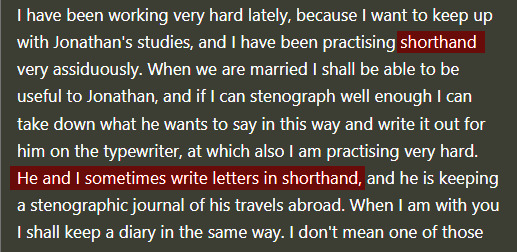
If this is your first time encountering shorthand then you're in for a treat. What's shorthand? Shorthand is a technique for writing very quickly.

At its basics you're writing sounds not spelling and combining simple lines to make full words.

Get it? You're optimizing for speed of writing not density or accuracy. So it's hard to read and takes up more space but you can write down notes fast. How fast? Here's someone writing at 120 words per minute.
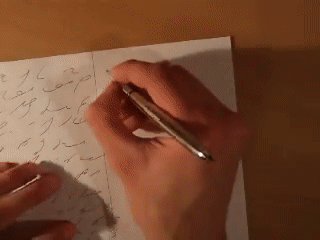
The world record is 250 wpm, but even with a little practice you can get a lot faster than cursive or print.
I've seen a few people ask if Jonathan is writing assuming Dracula can't read his notes. I don't know the answer to that, but I can share exactly that happening with Superman and Lex Luthor.

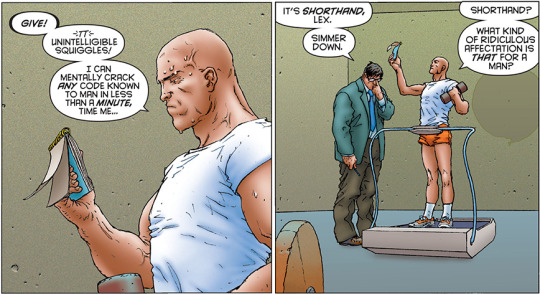
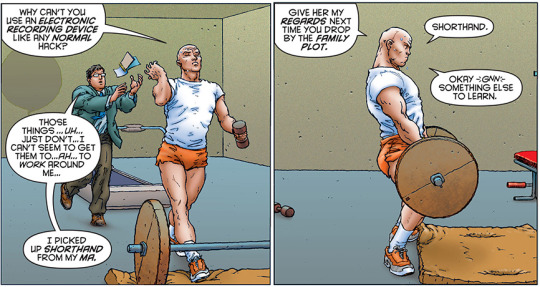
Naturally a reporter like Kent would use shorthand to quickly transcribe notes in the field.

This is the sort of think Mina is practicing specifically because it's the language used in business. You can read a great article on the expectations of men's and women's writing of the era here:
10K notes
·
View notes
Text

I know now the span of my life. God help me!
-Johnathan Harker
#Dracula#dracula daily#pitman shorthand#shorthand#may not be accurate as I'm studying Gregg not Pitman
763 notes
·
View notes
Text
Just plain babbling about shorthand
Since reading Dracula might be the first time or one of the first times that people have heard about shorthand, I thought I'd take this thin excuse to infodump. Because I find it fascinating and want to share. (Warning ahead of time, watch out for how many darn times I say "for example" in this post).
For some background, shorthand systems of writing have existed for millennia, but in the English-speaking world, the two most common and well-established systems of shorthand are Pitman and Gregg. Odds are that the Harkers are writing in Pitman. It's the older system (created in 1837) and is to this day more common in England and the Commonwealth. Gregg is more common in America and was introduced in 1888, either only a few years after or a few years before Dracula takes place. There were also numerous other less popular systems floating around at the time.
Pitman and Gregg and most other shorthand systems are phonetic. (Teeline is a more modern shorthand system based on a simplified alphabet, which is also quite popular). Simply put, each sound is reduced to one stroke of the pen. In Gregg, for example, the sound "k" (which includes the letter "c) is a medium-sized forward arch, "a" is a large circle, and "ch" is a short, downward diagonal line. So, instead of writing "catch" you just combine the symbols for "k-a-ch." Instead of "become" you just write "b-k-m." (These "words" are known as outlines).
Some shapes represent multiple sounds. For example, a small circle stands for the vowels in "bit," "bet," and "beet." A large circle stands for the vowels in "cap" and "cape." This might sound like it would be confusing rather than simplifying, but it's generally clear from the context.
There are a bunch of other means which allow you to write more quickly. Common words are further shorted into "brief forms." For example, "the" is represented by "th," "after" by "a-f," and "were" by "e-r." Some common endings or beginnings are also abbreviated, so that "sh" at the end of a word can stand in for "-tion" and "f" can mean "for-" or "fore-" at the beginning of a word. Thus, "Permission" is "p-r-m-sh" and "forgive" is "f-g-v." Common phrases can be combined into a single outlines. For example, for "to be" you can write "t-b" instead of "t-u[space]b." "I have not been able" can be "a-v-n-b-a." (The large circle "a" is the brief form for the word "I" in one of the rare quirks of Gregg that isn't basically intuitive).
Pitman Shorthand is very similar to Gregg (or, more accurately, Gregg is similar to Pitman). Other than using different symbols (for example, in Pitman "k" is a short forward line) Pitman differs from Gregg mostly by its use of the thickness of strokes to differentiate sounds. For example, "g" is also a short forward line, with the only difference being that the line for "g" is drawn thicker than "k."
I learned shorthand absolutely because of Dracula, though for convenience I learned Gregg. As of right now, I'm pretty out-of-practice, and honestly I was never particularly fast. (At my best, I probably was on average as fast writing shorthand as cursive longhand; I think faster than printing, though).
If you're at all interested, I really recommend learning some form of shorthand. It's useful in note-taking or when you don't want people to be able to read your writing (if, you know, you're kidnapped by a vampire or trying to write fanfic at work). It's also just a fun hobby and a nifty skill to be able to say you have.
In my opinion, if you want to learn shorthand, Gregg Simplified is a solid option, because the materials are accessible and the system is a good middle-ground between easiness to learn and quickness to write. I taught myself just following along with the Gregg Shorthand Manual Simplified. The book is broken up into 67 short "lessons." I did one or two lessons a week, maybe a few hours of work, and I was "fluent" in less than a year. I also bought a Gregg Simplified Dictionary, but all you need is the Manual.
(Note that the manual is written both assuming you're probably some kind a secretary and in the fifties. So, you'll learn brief forms for super-useful phrases like "dear sir" or "remit." For practice, they have you read and copy these sample letters in shorthand, and it's almost hilarious how almost all the letters to men are about business matters and the letters to women are advertising sales. There is one spectacular letter that's a man writing to a newspaper to cancel his subscription, because he's moved into a house in the suburbs with another man who gets the same paper. I'm legit tempted to go through the manual again just to find that letter.)
Fun fact! The fastest shorthand stenographer ever recorded wrote faster than the fastest typist.
Also fun fact! It's not uncommon for individual people to invent their own brief forms based on words that they use commonly. So, Jonathan might have been writing "c-a-r-p" (or the Pitman equivalent) for "Carpathian" or Mina writing "t-b" for "Whitby" or both of them writing "v-a-m" for vampire. And I'll bet credits to navy beans they had specific brief forms for their favorite trains.
#dracula#dracula daily#shorthand#gregg shorthand#pitman shorthand#the gregg book also is certain that you pronounce the “h” in “wh” words#maybe you still do#but probably you don't#*marge simpson potato meme but with me and shorthand*
222 notes
·
View notes
Text

(Written in shorthand.)
Count Elbertson is a strange man, I must say. When I greeted him, he introduced himself as “The Sus Guy”. I have never heard this term before. Is it unique to the foreign land of Las Vegas? Perhaps it is a Bostonian term? What queer language!
By the way, I asked Count Elbertson about this “meatgrinder” the villagers warned me about. I am relieved to know that it is just baseless superstition.
#Dracula Daily#currently gauging how cringe this is as I post it#pitman shorthand#my shorthand is a little wrong so what!#gives it character#shorthand#jerma#i was just thinking of things to practice shorthand with and I thought this one was mildly funny enough to post#jerma985#jonathan harker#anyway totally fucked that mina didn’t include this entry#jerma 985#jeremy elbertson#dracula
85 notes
·
View notes
Text
Not to be a bitch or anything but. Since people are reading Dracula daily again: if the shorthand tag becomes filled with non-shorthand Dracula content again I’m gonna start biting I’m so serious.
If Dracula is your intro to shorthand, and you’re thinking about learning it, cool ! Have fun ! But I’m literally begging you to stop tagging content that is only tenuously related to shorthand as “shorthand”. Please I’m so tired it’s such a small tag and it’s so easy for it to get completely overrun
#get it. I’m gonna start BITING ? geddit?#fun lil joke for the Dracula fans#pitman shorthand#shorthand#dracula#dracula daily#ceci says stuff
15 notes
·
View notes
Photo
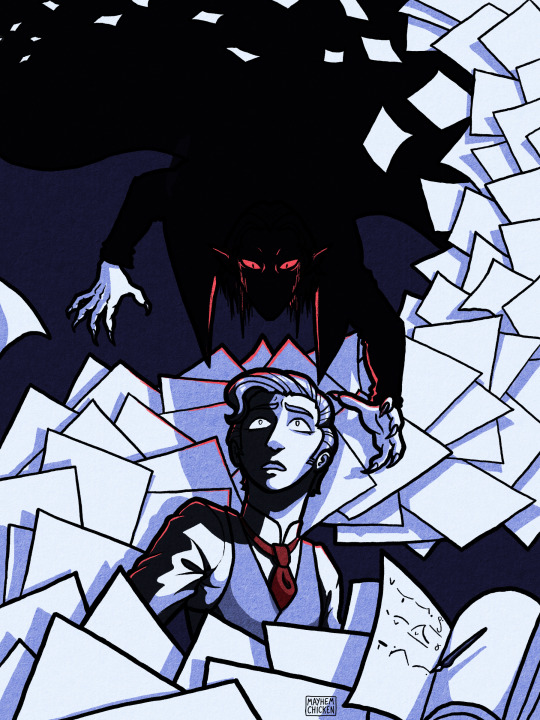
oh jonathan we’re really in it now
#art#artists on tumblr#dracula daily#dracula#jonathan harker#really enjoying this style + color palette combo#for the curious the corner text says#''I know now the span of my life. God help me''#in pitman shorthand#or at least it does if the translator i used is accurate
9K notes
·
View notes
Text


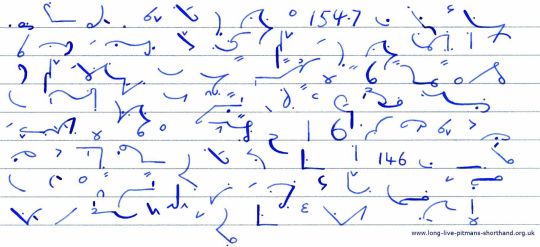

vampires and shapes....
#was Castlevania onto something with this one#also we don't know what shorthand Jonathan would use but from what i can tell pitmans would be very possible#they basically do all look like that though#Dracula daily#Dracula daily may 28#woes of emily#Netflix Castlevania
529 notes
·
View notes
Text

Loving all the Dracula talk on my dash due to Dracula Daily, and I wanted some writing practice, so allow me to present: Jonathan’s shorthand diary, in actual shorthand. …Probably not the right kind of shorthand. As a hobbyist American who does not own a fountain pen, I went with Gregg shorthand; Jonathan, being English in the 1890s, is much more likely to be writing in Pitman or one of its shorter-lived competitors. But I don’t think he ever specifies, and Gregg isn’t impossible (first documentation published in 1888, it just didn’t take off until maybe the 1910s) so, hey, it’s not not canon.
#dracula daily#starts at ‘left Munich at 8:35’#and runs to ‘Having had some time at my disposal when in London’#if it were Pitman it would look generally more spiky#and there would be a thick-thin line distinction#with the right kind of pen that’s easy to do by varying your writing pressure#if you mostly write in mechanical pencil then Pitman is not ideal for your purposes#update to last tag I have been told by Pitman writers that you can write it legibly with a pencil#apparently you vary the pressure to get dark pressed-hard lines or light sketchy lines and this is close enough to be readable#shorthand
946 notes
·
View notes
Text
it's going to be the funniest thing if daily dracula gets people to learn shorthand
anyways if you're interested in learning gregg shorthand (the American form of shorthand, so unfortunately not the one that would appear in dracula) the entire anniversary manual is available online along with exercise books and reading material:
87 notes
·
View notes
Text

Sounds like a plan
7 notes
·
View notes
Text
The use of English shorthand and typewriters expanded towards the end of the 19th century in clerical work in the major cities of the subcontinent. The use of shorthand in Indian languages, however, developed not in the context of office work but to meet the requirements of the new public sphere, particularly the quick notation of public speeches for reporting in newspapers. This led to the invention of new speed scripts, atitvarene lihiṇyāchī paddhatī (very speedy writing) or laghulekhan (shorthand) in Marathi, which relied heavily on Pitman and Munson’s English shorthand. Arguably the first use was in 1874 by RB Gunjikar [...]. Gajananbhau Vaijya, an English shorthand writer and reporter with the Indian Statesman, invented another speed script expressly for the quick notation of speeches [...]. Notably, Indian-language shorthand remained in the sphere of handwriting, as typewriters for non-Latin scripts did not become widespread in the subcontinent until the mid 20th century. [...]
[I]t is actually Bhujangrao Mankar, inventor of a third shorthand script with the book Laghulekhankalā (1897), who announced himself on the title page as the creator of Marathi and Gujarati shorthand. Mankar was a well-known English shorthand reporter for the press and the Criminal Investigation Department (CID) in Bombay for all manner of political meetings in the early 20th century. [...]
---
As Bernard Bate noted, Tamil shorthand came into its own when the colonial government attempted to acquire written transcripts of possibly seditious speeches during the Swadeshi movement.
In Bombay, too, shorthand found widespread application in CID surveillance with the growth in nationalist meetings and activity in the 1920s. Sub-inspectors could learn Marathi shorthand as an optional subject in the Central Police Training School; the usual practice was to pass a test in the office and regularly test for speed.
In the trial of the Ali brothers in Karachi following the Khilafat movement, speeches by Mohamed Ali and Shaukat Ali were entered as evidence of their seditious activity.
Similarly, charges against Communist leaders SA Dange, RS Nimbkar, and others in the Meerut conspiracy case (1929–33) were also based on their public speeches.
The cross-examination of witnesses turned on the accuracy of the transcripts and the methods used to obtain them and provides a rich window into the work of memory, notation, and translation involved in producing a speedy verbatim transcript of a public speech, and the issues of legibility, authenticity, and transparency that linked scribe, script, and language to state surveillance.
---
Police reporters usually translated the shorthand transcripts of speeches in various languages into English longhand as soon as possible. In Karachi the Ali brothers’ Urdu speeches were recorded in Urdu shorthand. In Belgaum in June 1921, however, sub-inspectors of the Pune CID took down their Urdu and English speeches in Marathi shorthand. During a meeting in Bagalkot, also in northern Karnataka, Shaukat Ali’s speech in Urdu was orally translated sentence by sentence into Kannada as he spoke [...]. There was thus much processing of sound, meaning, and sign across languages, scripts, memories, and individuals, all at high speed. [...] The inspector [...] Deshpande mentioned a critical aspect of Pitman-based shorthand writing: since the signs matched specific sounds, he did not pay much attention to the content of the speech; he just noted down the sounds as best he could, even if he didn’t know the meanings of words. Gaps between sounds and meaning, it would appear, were filled in either during transcription through memory recall or by the CID itself. [...] These practices of notation, translation, and judicial discourse grappled with a spectrum of textual reproduction of oral utterances, from gist to verbatim.
---
Text by: Prachi Deshpande. Scripts of Power: Writing, Language Practices, and Cultural History in Western India. 2023. [Bold emphasis and some paragraph breaks/contractions added by me.]
78 notes
·
View notes
Text
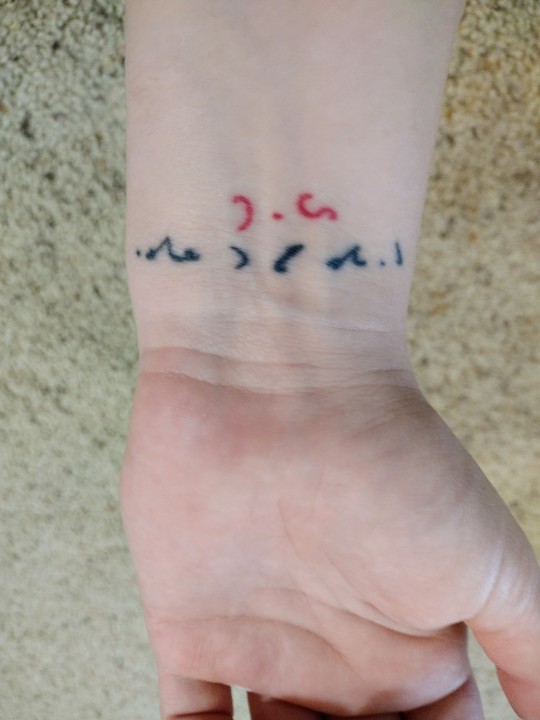
Seemed like a good time to post my Dracula tattoo! They're quotes from the epilogue in Pitman shorthand: "through the flames" in red text and "the happiness is well worth the pain" in black.
[ID: A photo of a pale wrist and open palm. On the wrist is a short row of red shorthand text and below it a longer line of black shorthand text. END ID]
#dracula#dracula daily#for the record i don't understand pitman shorthand#(i learned gregg like a true american)#so i'm just relying on the owner of a pitman website who transcribed it for me#like eight or nine years ago maybe#something something withstanding trauma#dracula is about being an adult child of an alcoholic
19 notes
·
View notes
Text
Dracula’s worst crime wasn’t “kidnapping innocents” or “murdering people” or “eating babies”. it was making me want to learn shorthand
#to be fair though it’s a lot easier to understand than it seems#but I don’t get how this makes people write faster#It takes me 20 minutes to write a sentence#Dracula daily#pitman shorthand#shorthand#dracula
78 notes
·
View notes
Text
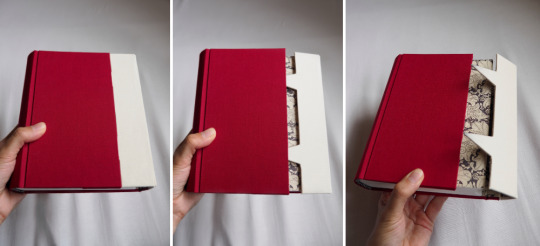
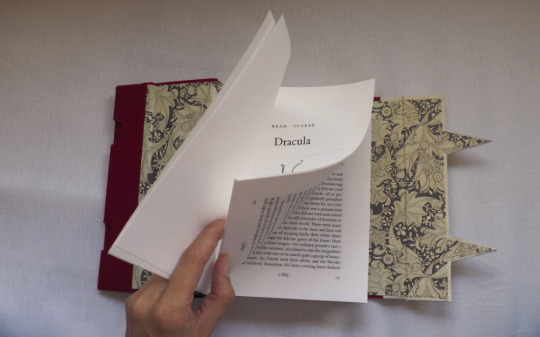


Dracula! 🧛
[Click on the pictures for better resolution.]
After my previous experiment with wrap-around hinges, I kept thinking about how to secure the wrap so it remains shut when the book is closed. When I started reading Dracula, the solution was obvious: vampire fangs that “bite” into the front cover!
Since almost all diary entries, letters, newspaper articles and telegrams in Dracula start with a date, I decided to have some fun there and set the date in a way that matches the item: different handwriting fonts for different recurring characters, a telegram font and a newspaper font, a little waveform separator for Dr. Seward's phonograph diary, and—my favourite—Pitman's shorthand for Jonathan and Mina's diaries.
I've been reading Dracula via the Dracula Daily substack and wanted to be able to carry on doing this also in this different media format, so I added an index that tells me the pages that belong to each day, and also added the dates to the footer.
More typesetting/binding notes under the cut:
⁂
Typesetting
Set mainly in ETbb (11/14), which is based on Bembo. The various decorative fonts were much harder to find than you'd think—sooo many cursive handwriting fonts on the web, but most of them look very modern or have horrible kerning or entirely unnatural character transitions. Explaining how I created the stenography bits (over 70 distinct little "intros"!) would really warrant a post of its own, but the short version is that I spent some time reading up on Pitman's shorthand, then used a tool that can, more or less, convert English (or phonetically written English) into shorthand, then double-checked various words with the help of old dictionaries on the Internet Archive and edited the strokes to my liking.
(The appendix includes a brief introduction to Pitman's shorthand as well as a dictionary-of-sorts for the stenography bits that appear in the book.)
2. Binding the textblock
Until now, the books I've bound have always been slim enough for me to get away with square-back bindings without the books looking too wedge-shaped, but Dracula here is just over 500 pages, so I figured it'd look better with a rounded spine. (Since backing the spine is beyond my expertise and I also don't have the tools for that, I skipped that step, but I'd love to give it a try someday.) To get the spine into a shape I liked and to glue it, I used two clamps, two sheets of cardboard, and two sturdy old encyclopedias, like so:

Which worked pretty well.
I sewed two-colour (b&w) headbands, this time with 2-ply embroidery thread:

3. The case:
The main part of the case is a Bradel binding with a rounded spine. The inside of the front cover contains an extra layer of bookboard with triangular cut-out that are slightly larger than the fangs, and partially covered with some thin cardboard.
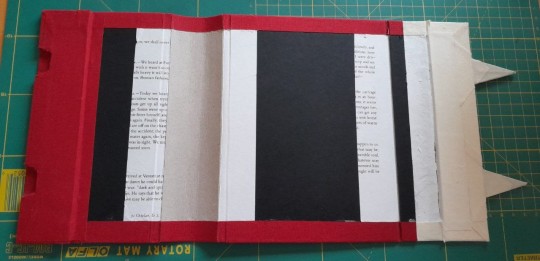
The white bookcloth unfortunately proved to be trickier to work with than I'd hoped: it's basically see-through (so I had to glue white paper to the outside of my black bookboard first) and smudges super easily.
If I do something like this again, I might consider making all of the front and back cover as thick as that fore-edge section of the front cover currently is, to make it look more even. Also, important lesson learned: even if everything fits together nicely when it's just bookboard and paper, adding bookcloth will make all the hinges much stiffer (I unfortunately had to redo the fore-edge hinges).
Cheers 🩸
473 notes
·
View notes
Text
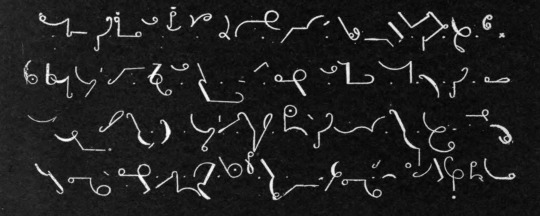
Scientific shorthand; a system based upon the Pitmanic alphabet. 1900.
Internet Archive
385 notes
·
View notes
Note
Hi! Do you happen to know if Jonathan and Mina would use Gregg or Pitman style during that era?
There's a good post I reblogged a while ago talking about shorthand, let me see... here it is!
Pitman seems most likely given its greater popularity in England at the time. While Mina at least would likely be interested in the most up-to-date methods, she's learning alongside/possibly beginning after Jonathan and intending it for help with his work. It would make sense for both of them to learn the more common one in their area/time. But I do like the idea of them learning or at least dabbling in other forms later on as well, possibly rarer ones (it's all over sure but the usefulness of the ability to ensure as few people as possible can read what you've written has been impressed upon them), or trying to practice a lot/possibly come up with their own alterations in order to be even faster (a race between Mina's typing vs Jonathan's shorthand sounds like the kind of nerdy fun competition they'd enjoy, or even a race between two different types of shorthand if/once fluent enough).
11 notes
·
View notes